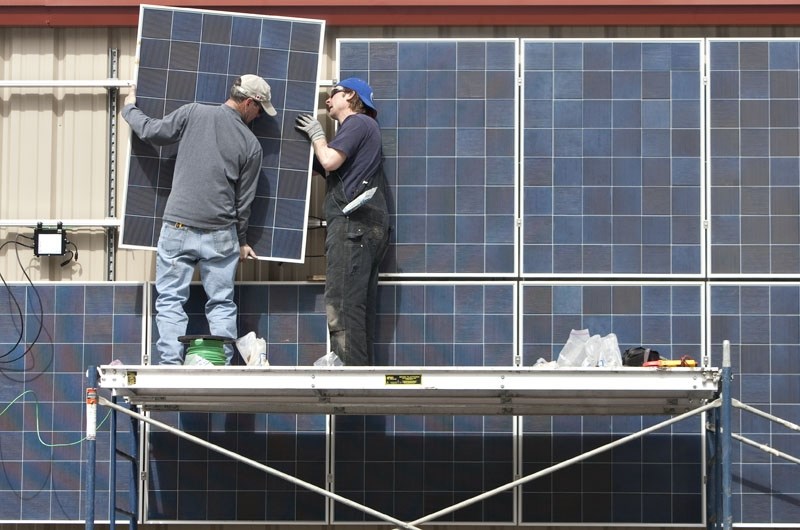St. Albert could save about $500,000 a year on the cost to run some of its biggest buildings, a new report suggests – but only if it invests almost $9 million.
City council received the 2016 energy and water conservation audit report this week. The report summarizes the results of energy and water efficiency audits Stantec Consulting recently did on 11 city-owned properties, including Servus Credit Union Place, St. Albert Place, and Fountain Park Pool.
The audits are part of the city’s efforts to reduce its greenhouse gas emissions. The city’s environmental master plan says that it aims to cut its corporate emissions to 20 per cent below 2008 levels by 2020; it was at eight per cent below as of last year.
The report found that the city’s buildings account for about 56 per cent of its carbon footprint, making them prime targets for reduction.
It also found that, with the exception of Servus Place, 10 out of the 11 buildings it audited used substantially more electricity and natural gas per square metre than equivalent structures elsewhere in Alberta. St. Albert Place and Fountain Park Pool were particularly wasteful, using some 3.7 and 4.4 times more energy (respectively) than the provincial average.
Stantec recommended a package of energy efficiency improvements that included efficient lights, occupancy sensors, and a cogeneration and heat-recovery system at Servus Place. These steps would cost about $1.647 million, save the city $315,000 a year, prevent about 2,335 tonnes of emissions per year (a little under half of what the city has to do to reach its target), and pay for themselves in about five years.
“These are really tried and true measures,” city strategic services director Leah Kongsrude told council Monday, with cogeneration being especially common and useful in heat-hungry recreation centres.
It also recommended adding solar panels to many buildings at a cost of $7.28 million ($6.48 million once you apply the provincial solar grant), which would save the city $200,000 a year and prevent another 2,000 tonnes a year of emissions. If the city did this and the previous improvements, it would make its money back in about 17 years.
These paybacks are based on today’s energy prices, which are at their lowest level in 10 years, Kongsrude said in an interview. (The city pays about five cents per kilowatt-hour for electricity today, for example, compared to about $0.12/kWh five years ago.)
“It’s extremely likely those prices will go up,” she said, given the provincial government’s plans to end coal-fired electricity, which would make these investments pay off faster.
While Stantec’s initial report recommended against putting up solar unless the city could get a deal on the capital cost, that recommendation was written prior to the province unveiling its recent carbon tax and municipal solar power grant, Kongsrude said. Take those into account, as well as the protection from power price fluctuations solar brings, and solar becomes worth it.
“If we want to meet our greenhouse gas reduction targets, this is one of the most viable ways to do it.”
St. Albert could have the largest municipal solar array in Canada if it put the maximum amount of panels possible on Servus Place, Kongsrude told council. (The report recommends a roughly $2 million installation that would account for 20 per cent of the building’s electricity use.)
Coun. Tim Osborne said it’s hard to walk around St. Albert now and not think about the impact of climate change, whether it be low water levels in the Sturgeon, the drying out of the John E. Poole wetland, or the wildfires raging in Alberta.
“Climate change is obviously real and we won’t mitigate its impacts unless we take real action,” he said.
“We owe it to our community to start looking at what we can do to make a difference.”
While she supported the report’s energy efficiency improvements, Coun. Sheena Hughes questioned the wisdom of investing in solar panels, estimating that they would take about 36 years to pay off on their own (assuming the city didn’t get any grants).
“At some point we have to say to ourselves when are we just making political statements at incredibly high costs and a very long rate of return to get our money back and when are we doing things that are going to actually be for the benefit of the city both short and long term?”
Some of these improvements (such as the light replacements and new boilers for St. Albert Place) are already in the city’s capital plan, Kongsrude said in an interview. The cogeneration, heat recovery, and solar options would be presented at budget this fall.
The report notes that these improvements alone would not be enough for the city to reach its climate target. Kongsrude said that the city could make additional reductions with its vehicles, streetlights, and sewers, which account for 41 per cent of its emissions.
The full report is available in the minutes of the May 16 council meeting.
What about water?
The report also looked at water use in the 11 city buildings. With the exception of Beaudry Place (which had water-wasting fixtures), it found no viable additional water conservation measures for the city to pursue. The report also found that, with the exception of Fountain Park Pool, each building used less water per square metre than the national average for comparable structures. <br />The audit did find that Fountain Park Pool was using an unusually large amount of water. Public works staffers are investigating, and suspect it could be the result of a leak or measurement error, city strategic services director Leah Kongsrude said in an interview.




